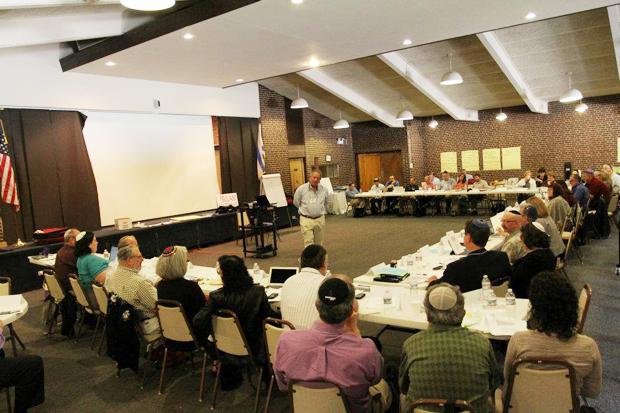Smaller congregations experimenting to stay vibrant, gaining attention from movements
Published June 17, 2012
CHICAGO — Sinai Synagogue in South Bend, Ind., has been struggling with issues facing many small congregations in an era of dwindling budgets and shifting demographics. In particular, with only 150 families, until recently it was increasingly difficult to find enough people for Shabbat services and Sunday school classes.
So Rabbi Michael Friedland found a solution that’s helping to reenergize the Conservative congregation — stop doing what’s always been done.
ADVERTISEMENT
In part, that meant moving weekday afternoon and Sunday Hebrew school classes to Shabbat morning, with the students and adults brought together for a communal lunch. Congregants with and without children saw something interesting happening, and participation soared from about 50 members on a typical Shabbat morning to 90.
Friedland’s is one of numerous approaches that congregations in small communities are employing to stay relevant and vibrant. Likewise, the initiatives are gaining the backing of national congregational arms, which in the past have been accused of having a big-city bias.
In fact, in early June the United Synagogue of Conservative Judaism hosted a conference outside of Chicago for communal rabbis and lay leaders of congregations with fewer than 250 members. The goal was to provide strategies for the communities to increase engagement and facilitate communication between clergy and members.
Friedland was one of the organizers of the event, which attracted nearly 50 representatives from 11 states.
“Approximately 40 percent of our congregations are what we consider small,” said Rabbi Charles Savenor, director of kehilla enrichment at the United Synagogue of Conservative Judaism, which says it has some 600 congregations in the United States. “This conference represents us putting more institutional effort into this area.”
ADVERTISEMENT
The Union for Reform Judaism, realizing that nearly 400 of its 900 congregations have 250 families or less, has started the Small Congregations Network aimed at increasing support to these communities and encouraging them to communicate among themselves about what strategies have been helpful. The network has started to look outside the URJ for effective strategies, taking good ideas wherever they can find them.
“It’s not just information that the Union for Reform Judaism creates and produces,” said Merry Lugasyi, the network’s director. “We’re now looking to other resources and whatever information is accessible.”
Likewise, the Orthodox Union has been running periodic Emerging Jewish Communities Fair since 2006 highlighting various small communities. The fair encourages people to move to the communities by discussing the advantages of being part of a small congregation.
Sinai’s solution was successful because it acknowledged what the Jewish movements and congregations across the country are starting to realize — that small communities are fundamentally different than large ones. For starters, programs that are the norm in big cities may fail to attract enough attention in a congregation that depends on a much higher percentage of participation in order to survive.
These smaller communities, often covering a relatively large area, need to experiment with new and exciting ways of engaging their congregations and creating services that their members look forward to attending.
Ensuring engagement is of paramount importance, but it’s not the only issue. Smaller congregations mean smaller membership fees, and distance from the Jewish communal centers means limited resources available. Innovative programs that could breathe new life into dwindling communities may need significant funds to operate, which small congregations rarely have. The solution is to rely on volunteers.
Congregation Kol Ami in Tampa, Fla., for example, has been using volunteers to draw people to its classes. Torah University, as the Conservative synagogue calls its innovative program, provides education for adults and children utilizing the rabbi, cantor and members of the community.
By offering credits for a fake graduation, the program employs the academic method in a way that attracts more students than a simple lecture series and has earned national awards for Kol Ami from the Conservative movement.
Savenor says the key to success for programs at smaller congregations is “healthy communication and relationships” between the laypeople and clergy. “Communication and role expectations are especially critical,” the rabbi said.
Another issue is providing high-quality Jewish education beyond what programs such as Torah University are able to offer. Volunteers may be well intentioned and enthusiastic, but often they are not trained educators and smaller communities may not be able to fund full-time staff.
For Orthodox families, the lack of Jewish day schools often is a primary reason why people leave for larger communities, according to Rabbi Steven Burg, managing director of the Orthodox Union.
“In an Orthodox community, there aren’t any options except for Jewish day schools,” he explained. “People move away because they don’t have a school for their children.”
The difficulty in finding a Jewish school has an impact on hiring clergy in general, as rabbis or cantors seeking a strong formal Jewish education for their children may opt to move away from an area by the time their kids enter grade school.
“Rabbis may stay for five to six years, then move on,” Burg said. “But while they’re there, they tend to be very dedicated and committed to the community.”
Smaller congregations do have their advantages. With limited resources, the rabbi may be more involved in the details of the community, allowing congregants to form a personal relationship that may not be possible in larger cities. Also, with housing, young couples might be attracted by the lower places in smaller cities, Burg said.
Teaching congregations how to address their challenges while keeping the unique flavor of a small community is vital.
“A Shabbat education model might help in a large community, too,” Sinai Synagogue’s Friedland said. “But in a small community it’s like the lifeblood. It gets everyone together and you build synergy.”![]()
















